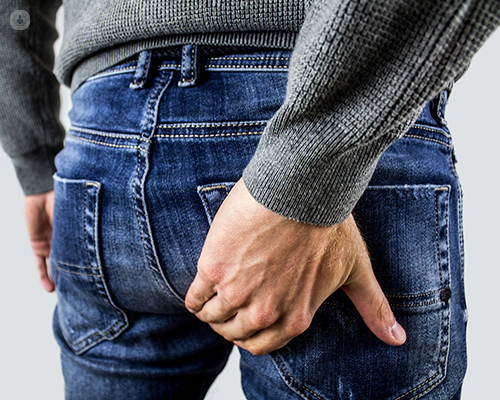Piles (haemorrhoids): What you need to know
Written in association with:Piles (haemorrhoids) are a common ailment that are especially prevalent in adults aged 45 to 65.
Here, Mr Daniel Baird, renowned consultant general and colorectal consultant surgeon, offers a comprehensive guide to piles, explaining risk factors, symptoms, and the various treatment options available for their management.

What are piles?
Piles, also known as haemorrhoids, are blood vessels in the rectum or anus that become enlarged. Piles are common, and can be internal or external.
What are the symptoms of piles?
If piles are symptomatic, they often present with a range of signs and symptoms, including:
- discomfort during bowel movements, especially when straining
- blood that appears as a vivid red colour on toilet paper or in the toilet bowl
- itching or irritation in the anal region
- swelling or a lump near the anus (with external piles)
Piles are generally benign. However, some symptoms of piles can overlap with symptoms of bowel cancer, such as rectal bleeding. If you experience any symptoms of concern, it's important to make an immediate appointment with your GP or with me for a detailed assessment.
What are the risk factors for developing piles?
Several factors can increase the risk of developing piles, including:
- Straining during bowel movements: Chronic constipation or straining during bowel movements can increase pressure on the blood vessels in the rectal area, contributing to the development of piles.
- Chronic diarrhoea: Persistent episodes of diarrhoea can irritate the rectal area and contribute to the development of piles.
- Pregnancy: The increased pressure on the pelvic blood vessels and hormonal changes during pregnancy can lead to the development or exacerbation of piles. Often, they will improve after giving birth.
- Obesity: Excess body weight, particularly in the abdominal area, can contribute to increased pressure on the blood vessels in the pelvic and rectal regions.
- Sedentary lifestyle: Lack of physical activity and prolonged periods of sitting or standing may contribute to the development of piles.
Additionally:
- Ageing: The ageing process can weaken the tissues supporting the blood vessels in the rectal area, making people more susceptible to piles.
- Genetic predisposition: Some people may have a genetic predisposition to developing piles, especially if there is a family history of the condition. Connective tissue disorders can also lead to piles.
- Heavy lifting: Regularly lifting heavy objects can contribute to increased pressure on the pelvic blood vessels.
- Chronic coughing: Conditions such as chronic bronchitis or persistent coughing can increase intra-abdominal pressure and contribute to the development of piles.
- Liver disease: Liver disease, particularly cirrhosis, can lead to increased pressure in the blood vessels of the abdominal region (portal hypertension), contributing to the development of piles.
- Inflammatory bowel disease (IBD): Conditions such as Crohn's disease or ulcerative colitis, which fall under the umbrella of IBD, can increase the risk of developing piles.
It's important to note that while these factors may increase the risk of piles, not everyone with these risk factors will develop the condition. Lifestyle modifications, including maintaining a high-fibre diet, staying hydrated, avoiding straining during bowel movements, and incorporating regular physical activity, can help reduce the risk of piles.
If you are experiencing symptoms suggestive of piles, such as pain, itching, bleeding, or swelling, make an appointment with me for a detailed assessment and management plan.
What are the most common complications of piles?
A pile can become strangulated or thrombosed (blocked off), and this can cause sudden and severe pain.
Occasionally, with long-standing and prolonged bleeding, the bleeding can lead to anaemia (low haemoglobin blood count). Any blood-thinning medicine can worsen this.
How are piles diagnosed?
Diagnosing piles typically involves a combination of:
- Medical history and physical examination: I will take a detailed history, inquiring about symptoms, including pain, bleeding, and changes in bowel habits. A physical examination, including a digital rectal exam, is typically performed as well.
- Proctoscopy or sigmoidoscopy: This will allow me to make an assessment of the internal component of the piles.
- Ruling out bowel cancer: Most rectal bleeding is innocent, however, cancer may be present in some patients. There are a few ways to manage that risk that can include stool tests, blood tests, and a colonoscopy.
With the above information, I will make an assessment of the piles and explain the findings and your bespoke management plan.
What is the general management of piles?
The management of piles depends on the severity of symptoms, the type of piles, and the presence of any complications. Conservative measures are often the first line of treatment, while more advanced cases may require medical procedures or surgery.
Conservative measures
- Dietary modifications: Increasing fibre intake can help soften stools and reduce straining during bowel movements. Patients are advised to eat a wide range of fresh fruit and vegetables.
- Hydration: Staying well-hydrated is important for maintaining soft stools.
- Weight management: For patients with a body mass index (BMI) above 25, losing weight is likely to be of benefit.
- Increase physical activity: For sedentary patients, increasing activity levels and exercising more will be of benefit. Lifting heavy weights in the gym is best avoided.
- Topical treatments: Over-the-counter creams, ointments, or suppositories may provide relief from symptoms and should be tried.
- Warm sitz baths: Immersing the rectal region in tepid water for 10-15 minutes several times daily can alleviate discomfort and facilitate the healing process.
Medical treatments
- Topical medications: Prescription-strength creams or ointments containing steroids or other anti-inflammatory agents may be recommended.
- Rubber band ligation: A rubber band is placed around the base of the haemorrhoid, cutting off its blood supply. The haemorrhoid shrinks and falls off in around a week.
- Sclerotherapy: An injection is administered into the haemorrhoid, causing it to shrink.
Operative management
If symptoms remain severe or if symptoms impact quality of life, then I will consider surgical options where appropriate. This may involve:
- Haemorrhoidectomy: This involves the excision of the piles under a general anaesthetic.
- Pexy: This involves stitching up the piles under a general anaesthetic. There are a few platforms that are aimed at delivering this treatment and they can be guided with an ultrasound to the blood vessels feeding the piles.
Individualised treatment plans are essential, and the choice of intervention depends on the patient's specific symptoms, the severity of haemorrhoids, and the response to conservative measures. It's crucial for people experiencing persistent or severe symptoms to seek medical advice for proper diagnosis and management.
If you would like to discuss this further, schedule an appointment with Mr Daniel Baird via his Top Doctors profile today.


